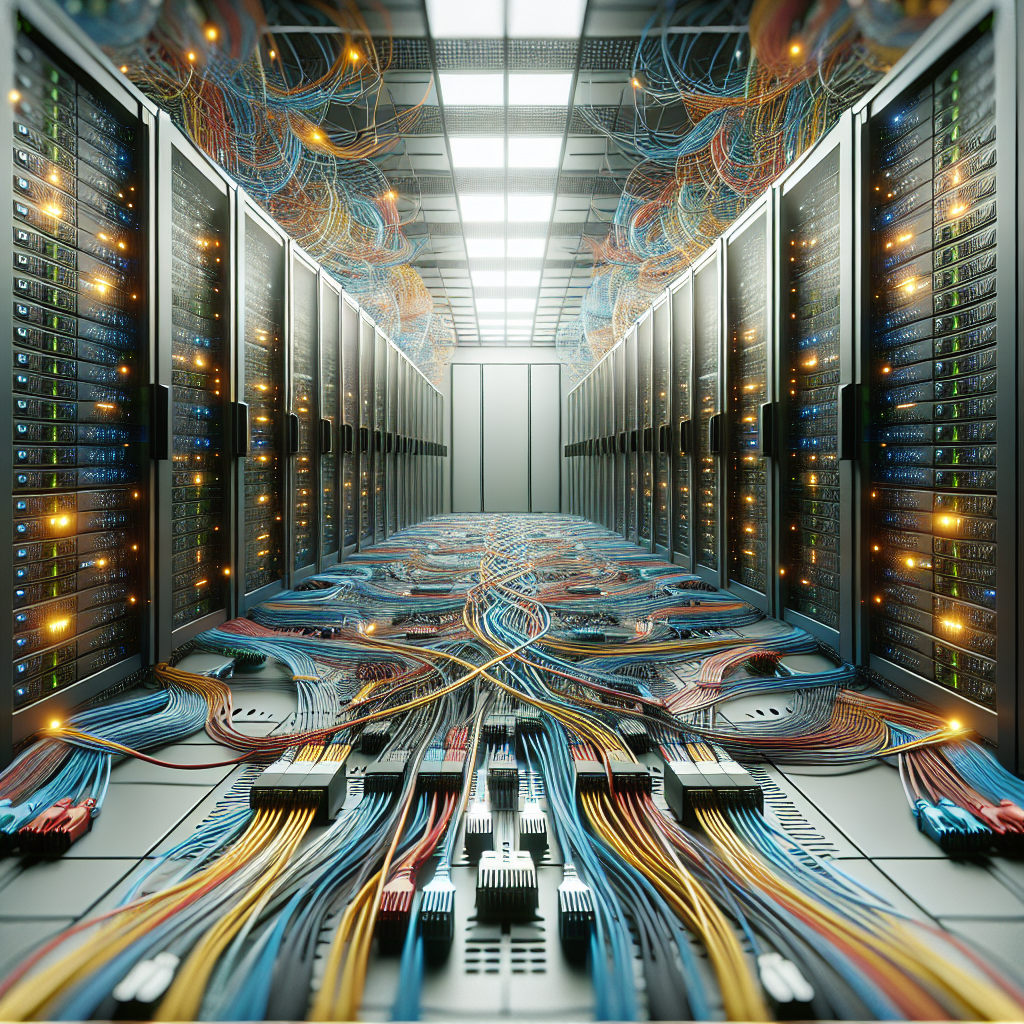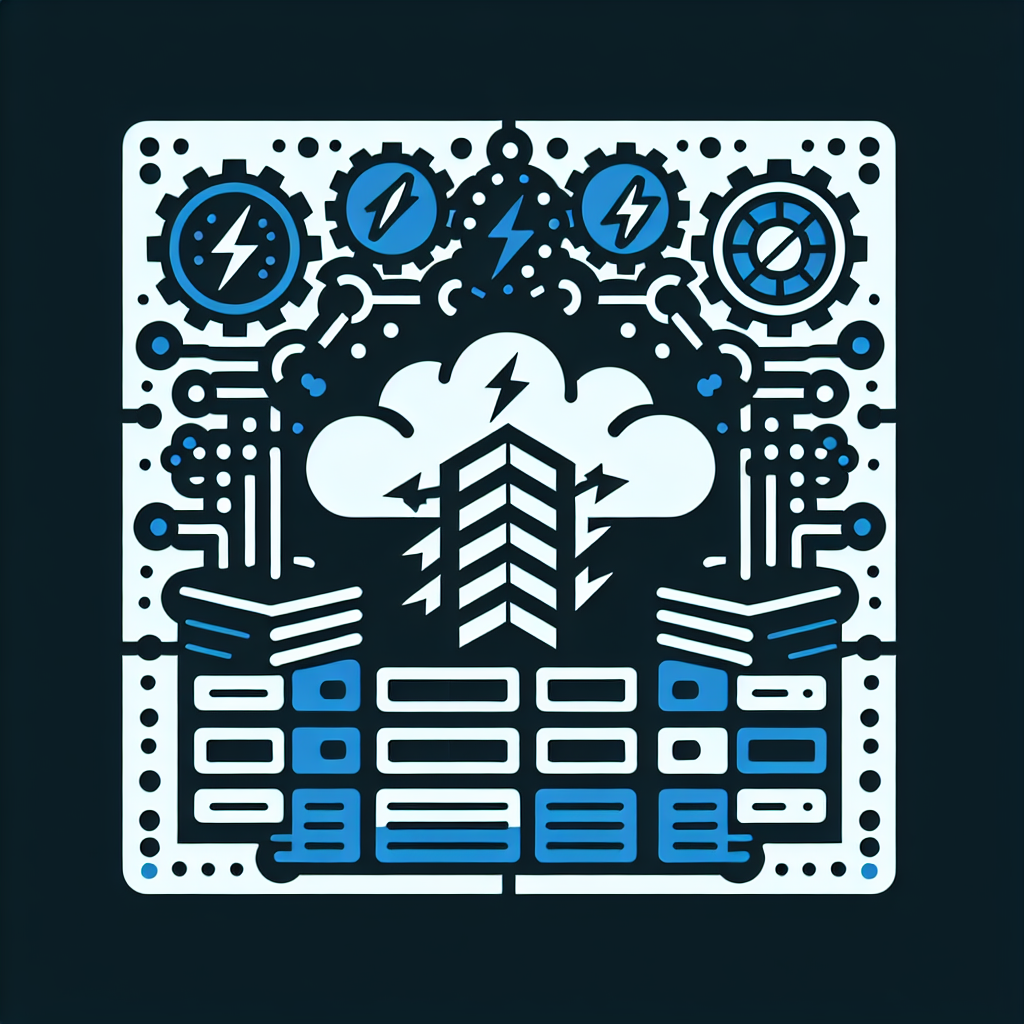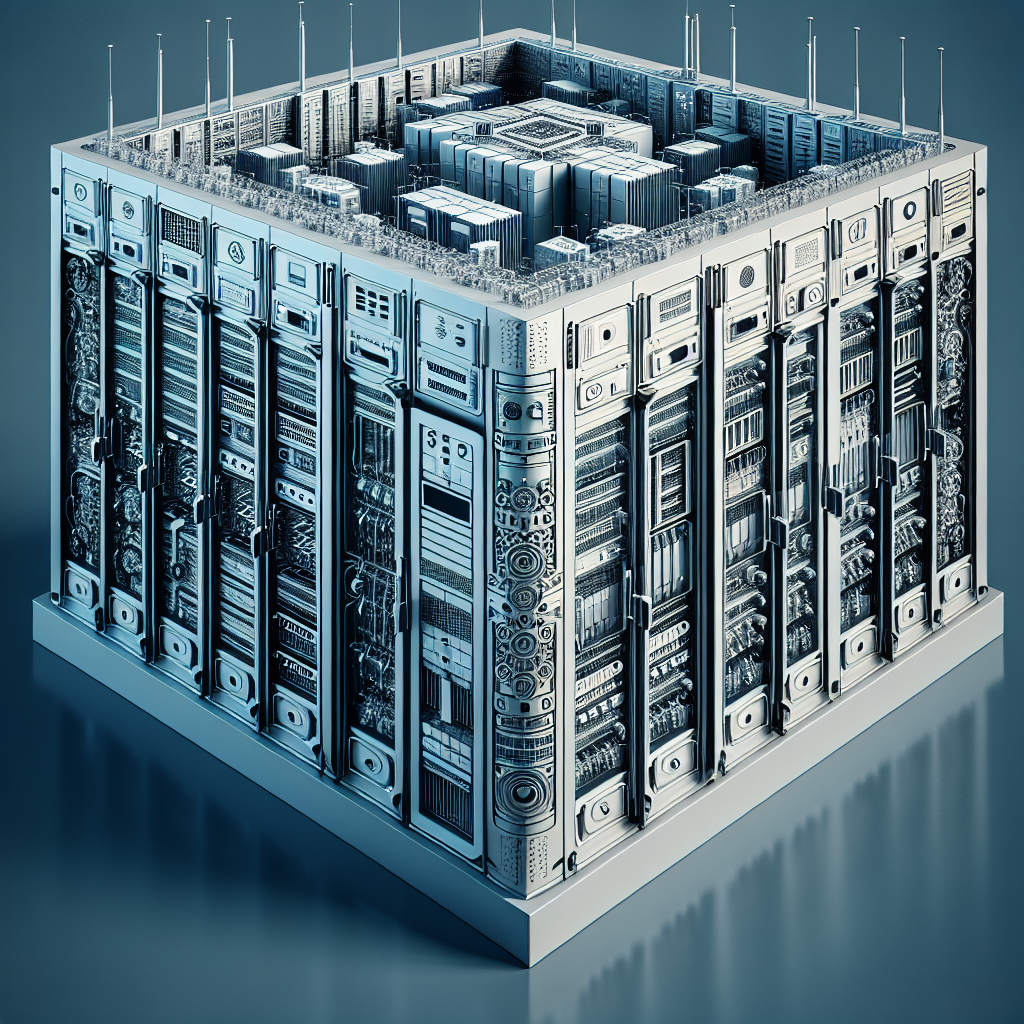Your cart is currently empty!
Tag: Scalability

The Impact of Scalability on Data Center Electrical Systems
Scalability is a crucial factor to consider when designing and operating data center electrical systems. As data centers continue to grow in size and complexity, the ability to scale up or down quickly and efficiently becomes increasingly important. In this article, we will explore the impact of scalability on data center electrical systems and discuss the challenges and opportunities it presents.One of the key challenges of scalability in data center electrical systems is the need to accommodate increasing power demands. As data centers expand and add more servers, storage devices, and networking equipment, the amount of power required to keep everything running smoothly also increases. This can put a strain on the existing electrical infrastructure, leading to potential issues such as overloading circuits, increased energy consumption, and higher operating costs.
To address these challenges, data center operators must carefully plan and design their electrical systems with scalability in mind. This includes ensuring that the power distribution infrastructure is robust enough to handle future growth, incorporating redundancy and backup systems to prevent downtime, and implementing energy-efficient technologies to reduce overall power consumption.
One approach to improving scalability in data center electrical systems is to use modular designs that allow for easy expansion and upgrades. Modular power distribution units, for example, can be quickly added or removed as needed to accommodate changes in power requirements. This flexibility not only makes it easier to scale up or down but also reduces downtime and maintenance costs.
Another important consideration when it comes to scalability is the use of renewable energy sources and energy storage systems. By incorporating solar panels, wind turbines, or other renewable energy sources into the data center’s electrical infrastructure, operators can reduce their reliance on traditional power grids and lower their carbon footprint. Energy storage systems, such as batteries or flywheels, can also help to smooth out fluctuations in power demand and improve overall system reliability.
In conclusion, scalability has a significant impact on data center electrical systems. By carefully planning and designing for future growth, implementing modular and energy-efficient technologies, and incorporating renewable energy sources, data center operators can ensure that their electrical infrastructure is able to meet the increasing demands of today’s digital economy. Ultimately, a scalable and resilient electrical system is essential for the success and sustainability of modern data centers.

Optimizing Data Center Storage for Scalability and Growth
In today’s digital age, data is king. Companies are collecting and storing more data than ever before, and as a result, data centers are becoming increasingly important. With the exponential growth of data, it is essential for data centers to be optimized for scalability and growth in order to meet the increasing demands placed on them.One of the key components of a data center is storage. Optimizing data center storage for scalability and growth is crucial for ensuring that the data center can handle the ever-increasing amounts of data being generated. There are several strategies that can be employed to optimize data center storage for scalability and growth.
One strategy is to implement a storage virtualization solution. Storage virtualization allows for the pooling of storage resources from multiple physical devices, creating a more flexible and scalable storage infrastructure. This can help to improve storage utilization and make it easier to scale storage capacity as needed.
Another strategy is to implement a tiered storage architecture. Tiered storage involves storing data on different types of storage media based on its importance and access frequency. By tiering the storage, companies can optimize performance and cost-effectiveness, while also ensuring that critical data is stored on the fastest and most reliable storage media.
Additionally, implementing data deduplication and compression technologies can help to optimize storage capacity and reduce storage costs. Data deduplication eliminates redundant data, while compression reduces the size of data files, allowing for more efficient use of storage space.
Furthermore, companies can consider deploying a software-defined storage solution. Software-defined storage separates the storage hardware from the storage management software, providing greater flexibility and scalability. This can help to simplify storage management and make it easier to scale storage capacity as needed.
In conclusion, optimizing data center storage for scalability and growth is essential for ensuring that data centers can meet the increasing demands placed on them. By implementing strategies such as storage virtualization, tiered storage, data deduplication, compression, and software-defined storage, companies can create a more flexible and scalable storage infrastructure that can easily adapt to changing storage requirements. With the right storage optimization strategies in place, data centers can be better equipped to handle the challenges of the digital age and support the growth of their businesses.

Maximizing Efficiency and Scalability with Data Center Cabling Solutions
In today’s fast-paced digital world, data centers play a crucial role in ensuring the smooth operation of businesses and organizations. The increasing demand for data storage and processing capabilities has led to the need for data center cabling solutions that can maximize efficiency and scalability.Efficiency is key when it comes to data center operations. The way data is transmitted and processed within a data center can significantly impact its performance. One of the most important factors in achieving efficiency is the cabling infrastructure. A well-designed and organized cabling system can help reduce latency, improve data transfer speeds, and minimize downtime.
Scalability is another critical aspect of data center operations. As businesses grow and data requirements increase, data centers need to be able to scale up their capabilities quickly and seamlessly. This is where scalable cabling solutions come into play. By implementing a cabling system that can easily accommodate additional servers, storage devices, and networking equipment, data centers can effectively meet the growing demands of their users.
There are several key considerations to keep in mind when designing a cabling system for a data center. First and foremost, it is important to choose the right type of cabling for the specific needs of the data center. Fiber optic cabling, for example, is ideal for high-speed data transmission and long-distance connections, while copper cabling is more cost-effective for shorter distances.
In addition to selecting the right type of cabling, proper planning and organization are essential for maximizing efficiency and scalability. Cables should be neatly organized and labeled to facilitate easy maintenance and troubleshooting. Cable management solutions such as cable trays, racks, and cabinets can help keep cables organized and prevent tangling or damage.
Furthermore, implementing a structured cabling system can simplify future expansions and upgrades. By following industry standards and best practices, data centers can ensure that their cabling infrastructure is flexible and adaptable to changing needs.
In conclusion, maximizing efficiency and scalability in data center operations requires careful planning and the right cabling solutions. By investing in a well-designed and organized cabling system, data centers can improve performance, reduce downtime, and effectively meet the growing demands of their users. With the right cabling solutions in place, data centers can stay ahead of the curve and remain competitive in today’s fast-paced digital landscape.

NetApp Storage: Enhancing Performance and Scalability for Businesses
In today’s fast-paced and data-driven world, businesses are constantly seeking ways to enhance performance and scalability in order to stay competitive. One solution that is gaining popularity among enterprises is NetApp storage.NetApp is a leading provider of storage solutions that help businesses manage and store their data more efficiently. With its advanced features and capabilities, NetApp storage is able to enhance performance and scalability for businesses of all sizes.
One of the key benefits of using NetApp storage is its ability to optimize data management. By using NetApp’s storage solutions, businesses can ensure that their data is stored in the most efficient way possible, reducing the risk of data loss or corruption. This in turn leads to improved performance and reliability of the overall IT infrastructure.
Additionally, NetApp storage solutions are designed to be highly scalable, allowing businesses to easily expand their storage capacity as their data needs grow. This flexibility is essential for businesses that are looking to grow and expand in the future, as it allows them to easily adapt to changing data storage requirements.
Another key feature of NetApp storage is its advanced data protection capabilities. With NetApp’s storage solutions, businesses can ensure that their data is safe and secure, even in the event of a disaster. This gives businesses peace of mind knowing that their valuable data is protected at all times.
In conclusion, NetApp storage is a powerful solution for businesses looking to enhance performance and scalability. With its advanced features and capabilities, NetApp storage can help businesses optimize data management, improve performance, and ensure data protection. By investing in NetApp storage solutions, businesses can stay ahead of the competition and drive success in today’s data-driven world.

Ensuring Scalability and Flexibility in Data Center Power Distribution
In today’s digital age, data centers play a crucial role in storing and processing vast amounts of information for businesses and individuals alike. With the ever-increasing demand for data processing power, it is essential for data center operators to ensure scalability and flexibility in their power distribution systems to meet the growing needs of their customers.Scalability in data center power distribution refers to the ability to easily expand or contract the capacity of the power infrastructure to accommodate changes in demand. This is particularly important in data centers, where power requirements can fluctuate significantly depending on factors such as the number of servers in use, the workload being processed, and the cooling systems in place. By designing a scalable power distribution system, data center operators can avoid downtime and inefficiencies caused by power shortages or overloads.
Flexibility, on the other hand, refers to the ability to adapt the power distribution system to meet changing requirements or to integrate new technologies and equipment. In today’s rapidly evolving technology landscape, data center operators need to be able to quickly and efficiently upgrade their power infrastructure to support the latest hardware and software innovations. This may involve adding new power distribution units, upgrading existing equipment, or implementing new power management software to optimize energy usage.
There are several key considerations data center operators should keep in mind when designing a scalable and flexible power distribution system. First and foremost, it is important to conduct a thorough assessment of current and future power requirements to determine the appropriate capacity needed. This may involve working closely with equipment vendors, power consultants, and energy suppliers to ensure that the power distribution system is designed to meet the specific needs of the data center.
Additionally, data center operators should consider implementing modular power distribution solutions that can easily be expanded or upgraded as needed. Modular power distribution units allow for quick and cost-effective scalability, as new modules can be added or removed without requiring significant downtime or disruption to operations. This approach also allows for greater flexibility in adapting to changing power requirements or integrating new technologies.
Furthermore, data center operators should prioritize energy efficiency in their power distribution systems to minimize costs and reduce environmental impact. This may involve implementing advanced power management software, utilizing energy-efficient hardware, and optimizing cooling systems to ensure that power is used as efficiently as possible. By reducing energy consumption, data center operators can not only save money on utility bills but also contribute to a more sustainable and environmentally friendly operation.
In conclusion, ensuring scalability and flexibility in data center power distribution is essential for meeting the growing demands of today’s data-driven world. By designing a scalable and flexible power distribution system, data center operators can avoid downtime, improve efficiency, and adapt to changing requirements with ease. By prioritizing energy efficiency and sustainability, data center operators can also reduce costs and minimize their environmental impact. Ultimately, investing in a robust and adaptable power distribution system is crucial for ensuring the long-term success and viability of a data center operation.

Scalability and Security: Key Considerations for Data Center Storage
In today’s digital age, data is the lifeblood of businesses. As the volume of data continues to grow exponentially, data center storage solutions must be able to scale to accommodate this growth while also ensuring the security and integrity of the data. Scalability and security are two key considerations for data center storage, and organizations must carefully evaluate their storage solutions to ensure they can meet both of these requirements.Scalability refers to the ability of a storage solution to accommodate increasing amounts of data without compromising performance or reliability. As businesses generate more data through digital transactions, IoT devices, and other sources, their storage needs will continue to increase. A scalable storage solution should be able to seamlessly expand to meet these growing demands, whether through the addition of more storage capacity or the integration of new technologies.
There are several factors to consider when evaluating the scalability of a data center storage solution. These include the ability to easily add new storage nodes or devices, the flexibility to scale storage capacity up or down based on changing needs, and the ability to support a wide range of data types and workloads. Organizations should also consider how well the storage solution can integrate with existing infrastructure and applications to ensure a seamless transition to a scalable storage environment.
Security is another critical consideration for data center storage. With the increasing frequency and sophistication of cyber-attacks, organizations must ensure that their data is protected from unauthorized access, data breaches, and other security threats. A secure storage solution should include robust encryption mechanisms to protect data both in transit and at rest, as well as access controls to restrict who can access and modify data.
When evaluating the security of a data center storage solution, organizations should consider factors such as compliance with industry regulations and standards, the ability to monitor and audit access to data, and the implementation of security best practices such as regular software updates and vulnerability assessments. Organizations should also consider the physical security of the data center itself, including measures such as access controls, surveillance cameras, and environmental controls to prevent unauthorized access or theft.
In conclusion, scalability and security are key considerations for data center storage solutions. Organizations must carefully evaluate their storage options to ensure they can accommodate the growing volume of data while also protecting it from security threats. By choosing a storage solution that is both scalable and secure, organizations can ensure that their data remains accessible, reliable, and protected in today’s digital landscape.

Ensuring Scalability and Flexibility with Modular Power Distribution Solutions for Data Centers
In today’s fast-paced digital world, data centers are becoming increasingly crucial for businesses of all sizes. As the demand for data storage and processing continues to grow, data center operators are faced with the challenge of ensuring scalability and flexibility in their power distribution solutions.One of the key factors in achieving scalability and flexibility in data center power distribution is the use of modular power distribution solutions. These solutions allow data center operators to easily add or remove power distribution units (PDUs) as needed, without requiring major infrastructure changes.
Modular PDUs also offer the flexibility to customize power distribution based on the specific needs of the data center. For example, data centers with high-density server racks may require PDUs with higher power capacities, while those with lower power requirements may opt for PDUs with lower capacities. By using modular PDUs, data center operators can easily adjust their power distribution to meet changing demands.
Another benefit of modular power distribution solutions is the ability to easily scale up as the data center grows. With traditional power distribution systems, adding additional power capacity can be a complex and time-consuming process. However, with modular PDUs, data center operators can simply add new units as needed, allowing for seamless expansion without disrupting operations.
In addition to scalability and flexibility, modular power distribution solutions also offer improved efficiency and reliability. By using intelligent PDUs with monitoring and management capabilities, data center operators can closely monitor power usage and identify potential issues before they lead to downtime. This proactive approach to power management can help prevent costly outages and ensure uninterrupted operation of critical IT infrastructure.
Overall, modular power distribution solutions are a cost-effective and efficient way for data center operators to ensure scalability and flexibility in their power distribution systems. By leveraging the benefits of modular PDUs, data centers can easily adapt to changing power requirements, improve efficiency, and enhance reliability to meet the demands of today’s digital economy.

Scalability and Flexibility in Data Center IT Operations: Strategies for Success
In today’s fast-paced business environment, data centers play a crucial role in enabling organizations to store, manage, and process vast amounts of data. As data volumes continue to grow exponentially, data center IT operations face the challenge of ensuring scalability and flexibility to meet the evolving needs of the business.Scalability refers to the ability of a data center to expand or contract its resources in response to changing demands. This is particularly important as businesses experience periods of rapid growth or seasonal fluctuations in data processing requirements. A scalable data center IT infrastructure allows organizations to add or remove servers, storage, and networking resources as needed, without causing disruptions to ongoing operations.
Flexibility, on the other hand, refers to the agility of a data center to adapt to new technologies, applications, and workloads. With technology evolving at a rapid pace, data centers must be able to support a variety of hardware and software platforms, virtualization technologies, and cloud services. A flexible data center IT environment enables organizations to leverage the latest innovations and stay ahead of the competition.
To achieve scalability and flexibility in data center IT operations, organizations can implement several key strategies for success:
1. Embrace virtualization: Virtualization technologies such as server virtualization, storage virtualization, and network virtualization enable organizations to consolidate resources, improve efficiency, and enhance flexibility. By virtualizing their infrastructure, data centers can quickly scale up or down their capacity to meet changing demands.
2. Adopt cloud services: Cloud computing offers a scalable and flexible alternative to traditional on-premises data center infrastructure. By leveraging cloud services such as Infrastructure as a Service (IaaS) and Platform as a Service (PaaS), organizations can easily expand their IT resources without the need for significant capital investment.
3. Implement software-defined networking (SDN): SDN allows organizations to programmatically control and manage their network infrastructure, enabling greater flexibility and scalability. By separating the control plane from the data plane, SDN simplifies network management and enables dynamic resource allocation.
4. Automate IT operations: Automation tools and technologies can streamline data center IT operations, reduce manual tasks, and improve efficiency. By automating routine processes such as provisioning, monitoring, and troubleshooting, organizations can free up resources to focus on strategic initiatives.
5. Monitor and optimize performance: Monitoring tools and performance analytics can help organizations identify bottlenecks, optimize resource utilization, and ensure optimal performance of their data center infrastructure. By continuously monitoring key metrics and performance indicators, organizations can proactively address issues before they impact business operations.
In conclusion, scalability and flexibility are essential components of a successful data center IT operations strategy. By embracing virtualization, cloud services, SDN, automation, and performance optimization, organizations can build a resilient and agile data center infrastructure that can support their evolving business needs. By investing in scalable and flexible IT operations, organizations can position themselves for success in an increasingly competitive and dynamic business landscape.
Scalability and Flexibility: How Data Center Servers Are Adapting to Changing Business Needs
In today’s fast-paced business environment, companies are constantly faced with the challenge of adapting to changing market conditions and customer demands. This requires a high level of scalability and flexibility in their IT infrastructure, particularly in the data center.Data center servers play a crucial role in supporting the operations of modern businesses, from processing and storing large volumes of data to running critical applications and services. As companies grow and evolve, their data center needs also change, requiring servers that can easily scale up or down to meet varying workloads.
Scalability is the ability of a system to handle increasing amounts of work or its potential to accommodate growth. In the context of data center servers, scalability is essential for businesses that experience fluctuating demand for their services. For example, during peak periods such as holiday seasons or major sales events, companies may need to quickly scale up their server capacity to ensure optimal performance and user experience.
Flexibility, on the other hand, refers to the ability of a system to adapt to different requirements or changes without significant reconfiguration. In the data center, flexibility is important for businesses that need to quickly deploy new applications or services, integrate new technologies, or respond to market shifts.
To meet the growing demand for scalability and flexibility, data center servers are evolving to incorporate advanced technologies and features that enable businesses to adapt to changing needs. One key trend in server design is the use of virtualization and cloud computing technologies, which allow companies to dynamically allocate resources and scale their infrastructure based on demand.
Another important development is the rise of hyper-converged infrastructure (HCI), which combines storage, networking, and compute resources in a single integrated system. HCI solutions offer greater flexibility and scalability compared to traditional server architectures, making it easier for businesses to manage their data center operations and scale their infrastructure as needed.
In addition, modern data center servers are designed to support software-defined networking (SDN) and software-defined storage (SDS), which enable businesses to automate and optimize their network and storage resources. These technologies provide greater flexibility in managing and provisioning server resources, allowing companies to adapt to changing business requirements more efficiently.
Overall, the growing complexity and demands of today’s business environment require data center servers to be highly scalable and flexible. By adopting advanced technologies and modern server architectures, companies can ensure that their IT infrastructure can easily adapt to changing needs and support their growth and success in the digital age.

Optimizing Data Center Cabling for Scalability and Flexibility in a Changing Landscape
Data centers are the backbone of modern businesses, providing the necessary infrastructure to support a wide range of critical applications and services. As organizations continue to grow and evolve, the demand for scalable and flexible data center solutions has never been higher. One key aspect of optimizing data center infrastructure for scalability and flexibility is ensuring that cabling is designed and implemented in a way that can easily adapt to changing requirements and technologies.In today’s rapidly changing landscape, data centers must be able to support a variety of different technologies, including cloud computing, virtualization, and big data analytics. This means that organizations need to have a data center cabling infrastructure that is not only capable of handling high bandwidth and low latency requirements, but also flexible enough to accommodate future growth and changes in technology.
One of the key considerations when optimizing data center cabling for scalability and flexibility is ensuring that the cabling infrastructure is designed with a modular approach. This means that cabling should be deployed in a way that allows for easy expansion and reconfiguration as needs change over time. By using modular cabling solutions, organizations can avoid costly and time-consuming cabling upgrades in the future, and instead simply add or remove cabling components as needed.
Another important aspect of optimizing data center cabling for scalability and flexibility is ensuring that cabling is properly organized and managed. This includes using cable management tools and techniques to keep cables neatly organized and easily accessible for maintenance and troubleshooting. By keeping cabling well-organized, organizations can reduce the risk of downtime due to cable failures and make it easier to scale up or reconfigure their data center infrastructure as needed.
In addition to modular design and proper organization, organizations should also consider using high-quality cabling solutions that are capable of supporting the latest technologies and standards. This includes using high-performance fiber optic cabling for high-speed data transmission, as well as copper cabling solutions that are capable of handling high bandwidth requirements. By investing in high-quality cabling solutions, organizations can ensure that their data center infrastructure is capable of supporting the latest technologies and can easily adapt to future changes in technology.
Overall, optimizing data center cabling for scalability and flexibility in a changing landscape requires careful planning and consideration of current and future requirements. By using a modular approach, organizing cabling effectively, and investing in high-quality cabling solutions, organizations can ensure that their data center infrastructure is capable of adapting to changing needs and technologies, while minimizing downtime and reducing costs in the long run.
